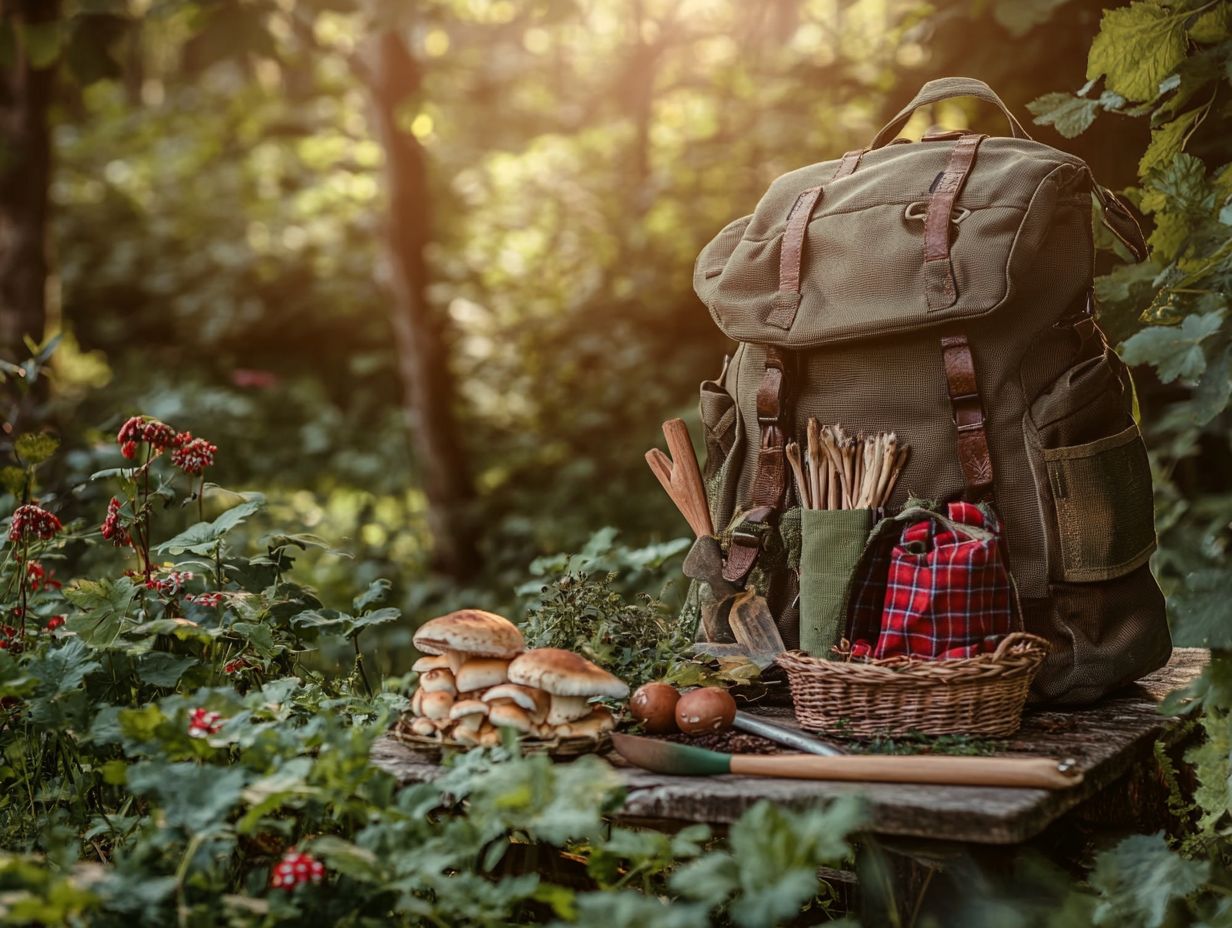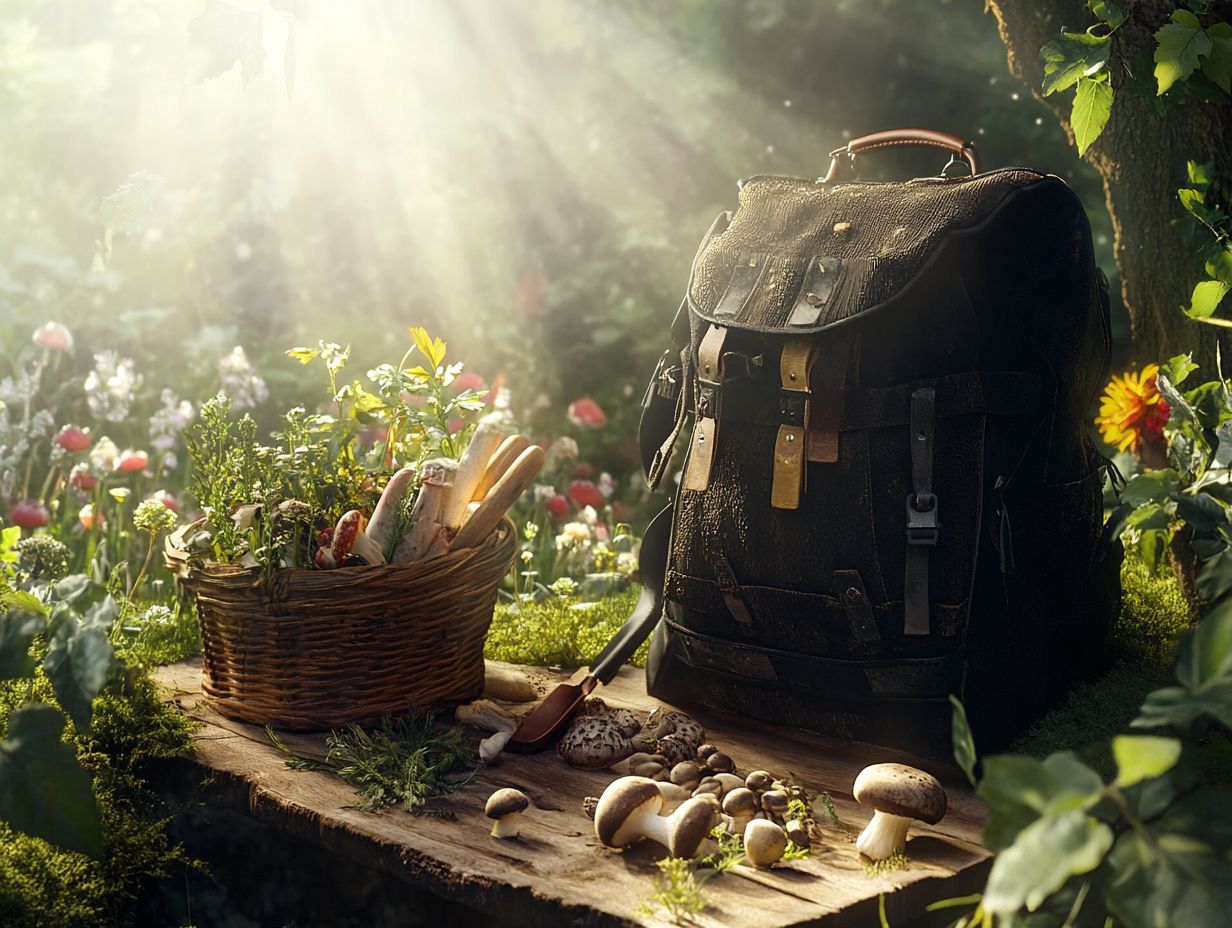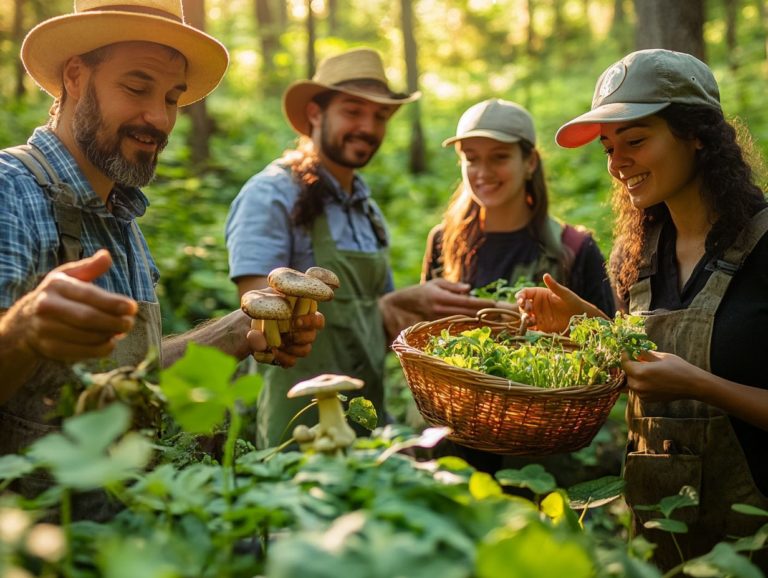How to Prepare for a Foraging Outing?
Foraging presents a captivating fusion of adventure, sustainability, and culinary pleasure. You have the opportunity to uncover the essentials of foraging, from identifying edible plants and fungi to selecting the right equipment and tools for a successful outing. Safety tips are at your disposal to ensure your security in the wild. You ll also learn the etiquette of responsible foraging.
Get ready for exciting recipes that will help you make the most of your foraging finds! Prepare to immerse yourself in the abundant treasures that nature has to offer!
Contents
Key Takeaways:

- Research the location and plan your route before heading out.
- Gather the right tools and supplies, like a basket, knife, and field guide.
- Practice responsible foraging by only taking what you need.
What is Foraging?
Foraging means searching for and gathering wild plants and edible foods. This practice helps you connect with nature and promotes sustainable harvesting.
Embracing this ancient tradition allows you to discover healthy food while contributing to the maintenance of biodiversity and gaining insights into local ecosystems. By engaging in foraging, you can enhance your health and well-being while cultivating a profound appreciation for the environmental benefits of wildcrafting.
Definition and Benefits
Foraging lets you find wild plants and foods while supporting environmental care. By immersing yourself in this fulfilling activity, you enjoy the health benefits of nutrient-rich wild foods and cultivate a sense of belonging through foraging workshops. These gatherings let you connect with others, share insights, and forge friendships, all while deepening your appreciation for local biodiversity.
As you hone your skills in identifying edible species, your ecological awareness grows. This allows you to grasp the delicate balance within ecosystems and the significance of ethical foraging practices. Respecting nature while collecting food nurtures your personal well-being and plays a crucial role in preserving the habitats that make foraging possible.
Essential Supplies for Foraging
To ensure your foraging outing is successful, arm yourself with the right tools and supplies. This includes having reliable equipment for plant identification, mastering safe harvesting techniques, and keeping a well-stocked first aid kit on hand for any unforeseen circumstances. Additionally, it’s wise to familiarize yourself with safety tips for foraging to enhance your experience.
Equipment and Tools
The right equipment and tools are essential for your foraging success. They enable you to accurately identify wild plants and harvest them responsibly, especially when considering what wildlife you should consider while foraging, including wild mushrooms and other edibles.
A robust field guide will become your invaluable companion, offering detailed descriptions, images, and seasonal insights to help you recognize various species. Additionally, knowing what to look for when foraging is crucial. High-quality foraging baskets or mesh bags are vital for collecting herbs and mushrooms, allowing for proper airflow to prevent spoilage.
For precision, a small trowel or folding knife is crucial for carefully uprooting or cutting plants without damaging their surroundings. Don t forget a good pair of gloves to ensure safety while handling unfamiliar flora.
By utilizing these tools thoughtfully, you can explore nature’s bounty with the confidence and respect it deserves.
Identifying Edible Plants and Fungi
Identifying edible plants and fungi is vital. It ensures the plants you gather are safe and supports biodiversity. With this knowledge, you can confidently explore the natural world, making informed choices that honor both your well-being and the environment.
Common Species and Characteristics

Some common wild plants you might find include dandelion, elderberry, and Oregon grape. Each has unique traits that make them valuable as wild edibles packed with health benefits.
Dandelions are more than just weeds. They are rich in vitamins A, C, and K, aiding digestion and reducing inflammation.
Elderberries are famous for their dark berries that boost your immune system. You can turn them into syrups or jams to fend off colds and flu.
Oregon grape has spiky leaves and vibrant yellow roots. It supports liver health and promotes good digestion.
Stay sharp! Watch out for invasive species that threaten local ecosystems. These plants can outcompete native varieties, disrupting natural habitats and diminishing your chances of finding these beneficial foraged options.
Foraging Safety Tips
Practicing safe foraging is key. Make sure the plants and fungi you gather are safe to eat.
Follow precautions, know about plant toxicity, and stick to food safety guidelines to protect your health.
By doing so, you also enhance your foraging experience, allowing you to fully enjoy the bounty of nature with confidence.
Precautions and Best Practices
When you go on a foraging adventure, take precautions to ensure a safe experience. It’s also helpful to learn how to start foraging as a hobby by understanding local guidelines about native species and conservation restrictions.
Always seek permission when harvesting from public lands or private properties. Avoid over-harvesting to protect local ecosystems.
Once you’ve gathered your bounty, proper identification of the foraged items is crucial after all, some plants can be toxic.
Engaging respectfully with local indigenous knowledge will not only enhance your foraging experience but also honor the traditions deeply connected to these practices.
Planning and Preparing for a Foraging Outing
Planning and preparing for your foraging outing demands meticulous location research and thoughtful route planning. If you’re unsure about where to begin, learning how to start foraging for wild edibles not only enhances your connection with nature but also enriches your engagement with the community by promoting responsible and sustainable foraging practices.
Location Research and Route Planning
Effective location research is essential for successful foraging. It helps you understand local ecosystems and harvest responsibly.
Familiarize yourself with local flora by consulting field guides or reliable online resources that spotlight the plants native to your area. This knowledge enables you to identify regions where wild plants thrive, such as woodland edges, wetlands, and meadows.
Consider using smartphone apps to enhance your foraging experience. They provide real-time information on plant identification and seasonal growth patterns.
Sticking to established trails or paths minimizes your impact on sensitive habitats, and being aware of weather conditions ensures your safety during your excursions.
Ultimately, these practices reinforce your commitment to ethical foraging, promoting both your personal safety and the health of the ecosystem.
Foraging Etiquette
Understanding foraging etiquette is crucial. It promotes responsible practices and helps maintain local ecosystems.
Embracing this knowledge allows you to forage responsibly while contributing to the health of your environment and the community around you.
Responsible Foraging Practices

Responsible foraging practices require you to adhere to established harvesting rules that promote ecological balance and minimize the environmental impact of gathering wild plants and fungi.
By understanding the unique life cycles of various species, you can ensure that you take only what is necessary. This allows plants to regenerate and thrive. This mindful approach not only honors the natural ecosystem but also supports local wildlife that depends on these plants for food and habitat.
Engaging with the community through workshops and discussions fosters a collective responsibility toward sustainable foraging. You can share knowledge and resources, which makes you and others more aware of the balance needed to maintain the variety of different plant and animal species and the health of your local environments.
Storing and Preparing Foraged Foods
Storing and preparing foraged foods properly is crucial for maintaining their quality and safety. You must employ effective cleaning techniques and appropriate storage methods to preserve the vibrant flavors and essential nutrients of these wild edibles.
These steps will help ensure that your foraged treasures remain both delicious and nourishing.
Proper Storage and Cleaning Techniques
To maintain the quality and safety of foraged foods, it s essential to employ proper storage and cleaning techniques. This includes thoroughly washing wild edibles and using the right containers for storage.
Handling each type of foraged item with care is key to preventing contamination and spoilage. For example, rinse leafy greens under cool running water to wash away any soil and insects, ensuring they re free from contaminants. For mushrooms, a gentle brush will do the trick to remove dirt without saturating them, as they can easily absorb moisture.
After cleaning, store these items in breathable bags or containers made of glass or food-grade plastic to help maintain their freshness. Understanding their specific storage needs like refrigeration for sensitive items or keeping others in cool, dark places can significantly enhance the longevity and quality of these natural treasures.
Recipes and Ideas for Using Foraged Foods
Are you ready to explore the exciting world of responsible foraging? Crafting exquisite recipes with foraged foods invites you to explore the remarkable culinary potential of wild edibles. It presents an opportunity to create unique and imaginative dishes that beautifully emphasize the rich flavors of nature!
Creative and Delicious Dishes
Crafting creative and delicious dishes with wild edibles allows you to elevate your culinary skills while savoring the unique flavors that foraged foods bring to your meals.
By exploring the diverse range of ingredients available in nature, you can unlock an array of vibrant tastes that transform a simple plate into a gourmet experience. Incorporating foraged plants, mushrooms, and herbs into your everyday cooking not only enhances flavor but also promotes a sustainable lifestyle.
Thoughtful recipe planning is essential when integrating these wild edibles. It allows you to pair ingredients that genuinely complement each other. Imagine a nettle pesto offering an exciting twist to traditional sauces, or elderflower adding a unique floral note to your desserts.
Embracing wild edibles fosters a deeper connection with your environment and nurtures a community that values the bounty of the land.
Frequently Asked Questions
What is foraging and why should I prepare for an outing?

Foraging is gathering wild food from nature. Understanding what beginners should know about foraging ensures you know how to safely gather food and have the right supplies.
What should I bring on a foraging outing?
Some essential items to bring on a foraging outing include a foraging guidebook or app, a basket or bag to collect food, a knife, and gloves. To ensure a successful experience, you might also want to check out what equipment you need for foraging. It is also important to bring plenty of water and a first aid kit in case of emergencies.
How should I dress for a foraging outing?
Dress smartly for your foraging adventure! Wear comfortable, sturdy shoes for walking and long pants to protect against thorns and insects. Additionally, keep in mind the top 5 tips for successful foraging to enhance your experience.
A hat and sunscreen are essential to shield yourself from the sun.
Where should I go for a foraging outing?
Look for areas with varied and plentiful wild plants and fungi. National parks, forests, and nature reserves are great choices.
Be sure to research any necessary permits or permissions before you go.
How can I ensure that I am foraging sustainably?
Only take what you need and always respect the environment. Avoid collecting rare or endangered species.
Spread out your gathering to protect the area and always dispose of any waste properly.
What precautions should I take when foraging for food?
Safety is your top priority. Always correctly identify plants and fungi before eating them, as some can be toxic.
Be aware of any allergies to foods, and if in doubt, don t eat it!






